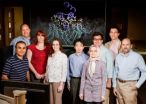(Press-News.org) Each time you see a person that you know, your brain rapidly and seemingly effortlessly recognizes that person by his or her face.
Until now, scientists believed that only a couple of brain areas mediate facial recognition. However, Carnegie Mellon University's Marlene Behrmann, David Plaut and Adrian Nestor have discovered that an entire network of cortical areas work together to identify faces. Published in the current issue of the Proceedings of the National Academy of Sciences (PNAS), their findings will change the future of neural visual perception research and allow scientists to use this discovery to develop targeted remedies for disorders such as face blindness.
"This research will change the types of questions asked going forward because we are not just looking at one area of the brain," said Nestor, a postdoctoral research fellow within CMU's Department of Psychology and lead author of the study. "Now, scientists will have to account for the system as a whole or else our ability to understand face individuation will be limited."
Behrmann, professor of psychology and a renowned expert in using brain imaging to study prosopagnosia, or face blindness, agreed.
"Faces are among the most compelling visual stimulation that we encounter, and recognizing faces taxes our visual perception system to the hilt. Carnegie Mellon has a longstanding history for embracing a full-system account of the brain. We have the computational tools and technology to push further into looking past one single brain region. And, that is what we did here to discover that there are multiple cortical areas working together to recognize faces," she said.
For the study, participants were shown images of faces while in a magnetic resonance imaging (MRI) scanner. Their task was to recognize different facial identities with varying facial expressions. Using dynamic multivariate mapping, the research team examined the functional MRI (fMRI) data and found a network of fusiform and anterior temporal regions that respond with distinct patterns to different identities. Furthermore, they found that the information is evenly distributed among the anterior regions and that the right fusiform region plays a central role within the network.
"Not only do we have a more clearly defined architectural model of the brain, but we were able to determine the involvement of multiple brain areas in face recognition as well as in other types of processes, such as visual word recognition," Behrmann said.
INFORMATION:
This study was funded by the National Science Foundation, and Behrmann received additional support from the Weston Visiting Professorship at the Weizmann Institute of Science.
Carnegie Mellon researchers uncover how the brain processes faces
Groundbreaking study identifies neural system responsible for face recognition
2011-06-01
ELSE PRESS RELEASES FROM THIS DATE:
AGU journal highlights -- May 31, 2011
2011-06-01
The following highlights summarize research papers that have been recently published in Geochemistry, Geophysics, Geosystems (G-Cubed), Geophysical Research Letters (GRL), the Journal of Geophysical Research-Atmospheres (JGR-D), the Journal of Geophysical Research-Biogeosciences (JGR-G), the Journal of Geophysical Research-Space Physics (JGR-A), Paleoceanography (PA), and Water Resources Research (WRR).
1. Analyzing subsurface oil and gas intrusions from Gulf spill
After the Deepwater Horizon blowout in 2010, hydrocarbons were released into the Gulf of Mexico. These ...
Egg cartons not accurate in reporting animal welfare claims
2011-06-01
CAMDEN – If you think that you're using humanely produced eggs for your omelets or deviled eggs, think again. Egg companies recognize that most Americans care about the welfare of farmed animals and many market their eggs with labels claiming the hens were treated well. But a Rutgers–Camden law professor warns that many of the animal welfare claims on egg cartons aren't all that they're cracked up to be.
Sheila Rodriguez, a clinical associate professor at the Rutgers School of Law–Camden, asserts that food consumers have a right to know how farm animals are raised and, ...
Team solves decades-old molecular mystery linked to blood clotting
2011-06-01
CHAMPAIGN, lll. — Blood clotting is a complicated business, particularly for those trying to understand how the body responds to injury. In a new study, researchers report that they are the first to describe in atomic detail a chemical interaction that is vital to blood clotting. This interaction – between a clotting factor and a cell membrane – has baffled scientists for decades.
The study appears online in the Journal of Biological Chemistry.
"For decades, people have known that blood-clotting proteins have to bind to a cell membrane in order for the clotting reaction ...
Scripps Research scientists find key mechanism in transition to alcohol dependence
2011-06-01
A team of Scripps Research Institute scientists has found a key biological mechanism underpinning the transition to alcohol dependence. This finding opens the door to the development of drugs to manage excessive alcohol consumption.
"Our focus in this study, like much of our lab's research, was to examine the role of the brain's stress system in compulsive alcohol drinking driven by the aversive aspects of alcohol withdrawal," said Scripps Research Associate Professor Marisa Roberto, Ph.D., senior author of the study.
"A major goal for this study," added Research Associate ...
Big city holds empty promise for bats
2011-06-01
In the treeless, flat Prairie, you'd think a city would provide a good home for bats who like to snuggle up and roost in trees and buildings. But researchers at the University of Calgary made the surprising discovery that the urban landscape is far from ideal for these animals.
"I was really surprised," says Dr. Joanna Coleman, a sessional lecturer and recent PhD graduate in biological sciences at the University of Calgary and lead author of the study. "I fully expected bats to benefit from the expected increase in availability of roosts and food – insects -- in the city. ...
Penn researchers help nanoscale engineers choose self-assembling proteins
2011-06-01
PHILADELPHIA — Engineering structures on the smallest possible scales — using molecules and individual atoms as building blocks — is both physically and conceptually challenging. An interdisciplinary team of researchers at the University of Pennsylvania has now developed a method of computationally selecting the best of these blocks, drawing inspiration from the similar behavior of proteins in making biological structures.
The team was led by postdoctoral fellow Gevorg Grigoryan and professor William DeGrado of the Department of Biochemistry and Biophysics in Penn's Perelman ...
1-ON-1 WordPress Training - Get Help Building Your WordPress Website or Blog with 1-ON-1 WordPress Training
2011-06-01
The #1 ranked WordPress Training company announces they are providing private 1-ON-1 WordPress Training to individuals wanting t tailor their wordpress training needs to their own pace and also focus the training on THEIR OWN WEBSITES.
That's right, if you're looking for wordpress training from WP professionals now you can have the training or help you require tailored to YOUR needs or have the wordpress training professional assist you in teaching you how to customize or set-up YOUR specific website.
Aperio has found through it's over 1,500 students whom have taken ...
Potential new drug candidate found for Alzheimer's disease
2011-06-01
Researchers at the University of California, San Diego, the Medical University of South Carolina and American Life Science Pharmaceuticals of San Diego have demonstrated that oral administration of a cysteine protease inhibitor, E64d, not only reduces the build-up of β-amyloid (Aβ) in the brains of animal models for Alzheimer's disease, but also results in a substantial improvement in memory deficit.
A paper detailing the findings has been published as an early online version and is scheduled for publication in the September 6 issue of the Journal of Alzheimer's ...
FRAVE: Flexible virtual reality system
2011-06-01
Product designers harness time-consuming procedures in prototype construction. Only then are they able to assess the results of their work in a comprehensive manner. In a three-dimensional model world, they are able to do so instantly and can experience how the product fits into its natural surroundings. Design alterations can be visualized immediately, saving time and cutting the costs associated with the development process.
Up to now, the so-called CAVE has been used. This consists of between three and six projection surfaces that create a walk-in space. Video projectors ...
AmericaChamber.com, the Chamber That Means Business, Announces the New Executive Board and Declares that Local, Regional and National Companies May Create a Free User Account at AmericaChamber.com
2011-06-01
The America Chamber of Commerce is pleased to announce that Jack Miller, President and CEO; Ely Miller, EVP and COO; Lorin Morar, VP Software Development were elected to the Executive Board which offers all local, regional, national and international companies to create a free user account at AmericaChamber.com.
About America Chamber
America Chamber was created to drive unique traffic between entrepreneurs throughout America so that they can do business with each other on a local, regional, national and international basis. We are neither a buyers club nor just a website ...
LAST 30 PRESS RELEASES:
The Ceramic Society of Japan’s Oxoate Ceramics Research Association launches new international book project
Heart-brain connection: international study reveals the role of the vagus nerve in keeping the heart young
Researchers identify Rb1 as a predictive biomarker for a new therapeutic strategy in some breast cancers
Survey reveals ethical gaps slowing AI adoption in pediatric surgery
Stimulant ADHD medications work differently than thought
AI overestimates how smart people are, according to HSE economists
HSE researchers create genome-wide map of quadruplexes
Scientists boost cell "powerhouses" to burn more calories
Automatic label checking: The missing step in making reliable medical AI
Low daily alcohol intake linked to 50% heightened mouth cancer risk in India
American Meteorological Society announces Rick Spinrad as 2026 President-Elect
Biomass-based carbon capture spotlighted in newly released global climate webinar recording
Illuminating invisible nano pollutants: advanced bioimaging tracks the full journey of emerging nanoscale contaminants in living systems
How does age affect recovery from spinal cord injury?
Novel AI tool offers prognosis for patients with head and neck cancer
Fathers’ microplastic exposure tied to their children’s metabolic problems
Research validates laboratory model for studying high-grade serous ovarian cancer
SIR 2026 delivers transformative breakthroughs in minimally invasive medicine to improve patient care
Stem Cell Reports most downloaded papers of 2025 highlight the breadth and impact of stem cell research
Oxford-led study estimates NHS spends around 3% of its primary and secondary care budget on the health impacts of heat and cold in England
A researcher’s long quest leads to a smart composite breakthrough
Urban wild bees act as “microbial sensors” of city health.
New study finds where you live affects recovery after a hip fracture
Forecasting the impact of fully automated vehicle adoption on US road traffic injuries
Alcohol-related hospitalizations from 2016 to 2022
Semaglutide and hospitalizations in patients with obesity and established cardiovascular disease
Researchers ‘listen in’ to embryo-mother interactions during implantation using a culture system replicating the womb lining
How changing your diet could help save the world
How to make AI truly scalable and reliable for real-time traffic assignment?
Beyond fragmented markets: A new framework for efficient and stable ride-pooling
[Press-News.org] Carnegie Mellon researchers uncover how the brain processes facesGroundbreaking study identifies neural system responsible for face recognition




